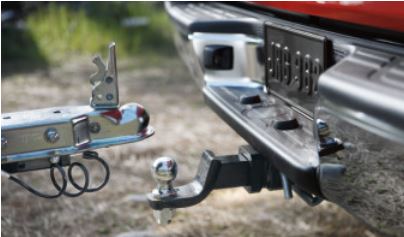There are many types of hitches used to attach a trailer to a tow vehicle. The three main types are; the bumper-pull, a gooseneck, and a fifth wheel. Here, we will address the proper way to hook up a bumper-pull trailer.
Before hooking up any trailer to your vehicle and driving off, it is absolutely necessary to make sure your vehicle and your hitch are rated for enough weight to properly support both the towing weight and the tongue or coupler weight of the trailer. These numbers are typically located inside the door frame of the tow vehicle, on the hitch itself, and on the plaque on the side of the trailer. Consult your manuals for details.
Three steps to hooking up the trailer:
1. Making the physical hitch connection.
2. Attaching the safety cables.
3. Make electrical connections.
Check to ensure that the coupler size on the trailer equals the ball size on the hitch. For example, if you have a 2-inch coupler on your trailer, you must have a 2-inch ball on your tow vehicle. These must match.
To make the connection, first, make sure that the coupler on the trailer is adjusted high enough off the ground to be above the top of the hitch ball. At the trailer coupler, make sure the latch mechanism is in the open position. This is either slid backwards towards the trailer or rotated 90° vertically. Back the vehicle up to the trailer so that the ball sits directly below the coupler. Stop the vehicle and set your parking brake. Once the ball and coupler are aligned, lower the trailer coupler down onto the ball. This is either done by manually cranking a gearbox or pressing a button that drives an electric motor up and down. To make a proper connection, the coupler must sit completely down on top of and encompassing the ball. Keep dropping the trailer down onto the ball until all its weight is resting on the tow vehicle ball. Close the latching mechanism by either sliding it forward until it locks into place or flipping the handle down 90° so it latches. The trailer is now attached to the vehicle. If the connection is made properly, you should be able to add a coupling lock or a latch pin through the latch handle to be sure it cannot be released. Ensuring this connection is made properly is probably the most important step in the process.
Next, the safety chains must be attached from the trailer to the tow vehicle. The chains should be positioned so that they cross under the ball and attach to the slots on both sides of the receiver hitch of the tow vehicle. The chains should be slack enough so there is no chance of binding with the hitch but should not droop low enough where they could drag on the ground or over bumps.
Now for the electrical connections. Depending on the trailer and tow vehicle, the electrical plugs can have anywhere from 4 to 7 wires in them. Your tow vehicle connection must match the connection of the trailer. If the trailer only has a 4-wire connection, then you are just hooking up the trailer lights. If the trailer has seven wires in the socket, then the trailer is large enough that has brakes too. When this connection is made, not only are you hooking up the lights, but you are also hooking up the electric brakes for the trailer. Again, ensure that the wires from the trailer to the tow vehicle are not interfering with the hitch or the safety chains and not drooping where they can touch the ground.
Some trailers have a secondary safety system for the brakes that also need to be connected to the tow vehicle. This is usually a small steel cable that would loop down from the coupler on the trailer and be connected to the tow vehicle. This connection is made to ensure that if there is a problem and the trailer disconnects from the tow vehicle, this mechanical cable would be pulled and would immediately lock the brakes on the trailer so it would not go farther than necessary.
At this point, all your connections are finished. Have another person stand behind the trailer and verify that the lights are all functioning properly (test running lights, turn signals, and brake lights). Last, if equipped with brakes, pull the tow vehicle and trailer forward slowly and test the brakes to ensure they are working. If all checks out, you are good to go.
Anytime you stop for fuel or stretch breaks, check that all of your connections are as you expect and adjust as necessary.
Enjoy the trip!


